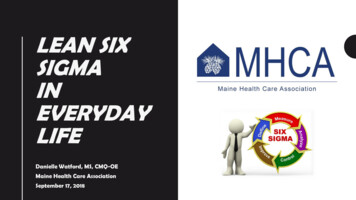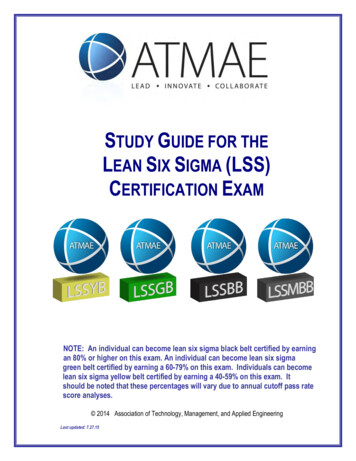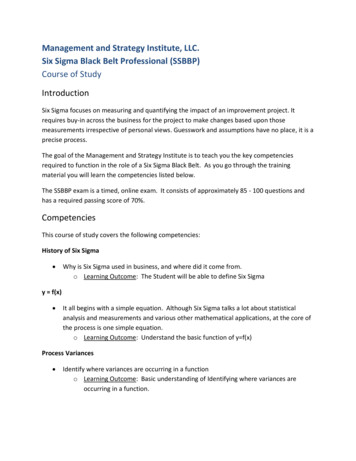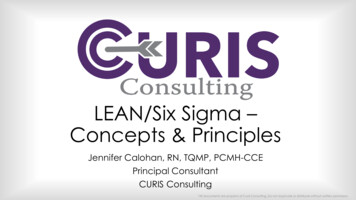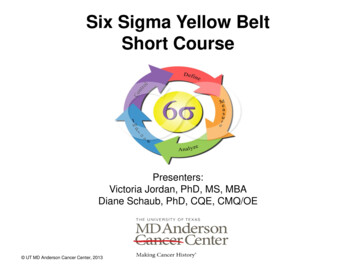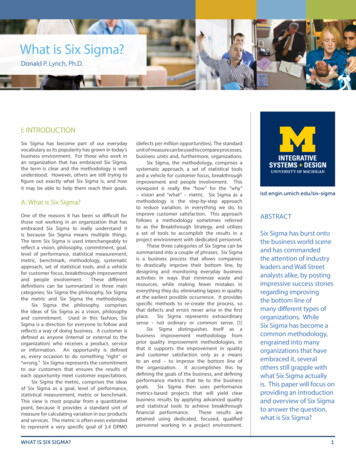
Transcription
What is Six Sigma?Donald P. Lynch, Ph.D.I: INTRODUCTIONSix Sigma has become part of our everydayvocabulary as its popularity has grown in today’sbusiness environment. For those who work inan organization that has embraced Six Sigma,the term is clear and the methodology is wellunderstood. However, others are still trying tofigure out exactly what Six Sigma is, and howit may be able to help them reach their goals.A: What is Six Sigma?One of the reasons it has been so difficult forthose not working in an organization that hasembraced Six Sigma to really understand itis because Six Sigma means multiple things.The term Six Sigma is used interchangeably toreflect a vision, philosophy, commitment, goal,level of performance, statistical measurement,metric, benchmark, methodology, systematicapproach, set of statistical tools, and a vehiclefor customer focus, breakthrough improvementand people involvement.These differentdefinitions can be summarized in three maincategories; Six Sigma the philosophy, Six Sigmathe metric and Six Sigma the methodology.Six Sigma the philosophy, comprisesthe ideas of Six Sigma as a vision, philosophyand commitment. Used in this fashion, SixSigma is a direction for everyone to follow andreflects a way of doing business. A customer isdefined as anyone (internal or external to theorganization) who receives a product, serviceor information. An opportunity is definedas, every occasion to do something “right” or“wrong.” Six Sigma represents the commitmentto our customers that ensures the results ofeach opportunity meet customer expectations.Six Sigma the metric, comprises the ideasof Six Sigma as a goal, level of performance,statistical measurement, metric or benchmark.This view is most popular from a quantitativepoint, because it provides a standard unit ofmeasure for calculating variation in our productsand services. The metric is often even extendedto represent a very specific goal of 3.4 DPMOWHAT IS SIX SIGMA?(defects per million opportunities). The standardunit of measure can be used to compare processes,business units and, furthermore, organizations.Six Sigma, the methodology, comprises asystematic approach, a set of statistical toolsand a vehicle for customer focus, breakthroughimprovement and people involvement. Thisviewpoint is really the “how” for the “why”– vision and “what” – metric. Six Sigma as amethodology is the step-by-step approachto reduce variation, in everything we do, toimprove customer satisfaction. This approachfollows a methodology sometimes referredto as the Breakthrough Strategy, and utilizesa set of tools to accomplish the results in aproject environment with dedicated personnel.These three categories of Six Sigma can besummarized into a couple of phrases. Six Sigmais a business process that allows companiesto drastically improve their bottom line, bydesigning and monitoring everyday businessactivities in ways that minimize waste andresources, while making fewer mistakes ineverything they do, eliminating lapses in qualityat the earliest possible occurrence. It providesspecific methods to re-create the process, sothat defects and errors never arise in the firstplace.Six Sigma represents extraordinarysense - not ordinary or common sense. [1]Six Sigma distinguishes itself as abusiness improvement methodology fromprior quality improvement methodologies, inthat it supports the improvement in qualityand customer satisfaction only as a meansto an end – to improve the bottom line ofthe organization.It accomplishes this bydefining the goals of the business, and definingperformance metrics that tie to the businessgoals.Six Sigma then uses performancemetrics-based projects that will yield clearbusiness results by applying advanced qualityand statistical tools to achieve breakthroughfinancial performance.These results areattained using dedicated, focused, qualifiedpersonnel working in a project ix Sigma has burst ontothe business world sceneand has commandedthe attention of industryleaders and Wall Streetanalysts alike, by postingimpressive success storiesregarding improvingthe bottom line ofmany different types oforganizations. WhileSix Sigma has become acommon methodology,engrained into manyorganizations that haveembraced it, severalothers still grapple withwhat Six Sigma actuallyis. This paper will focus onproviding an introductionand overview of Six Sigmato answer the question,what is Six Sigma?1
“One of thereasons it has beenso difficult for thosenot working in anorganization thathas embraced SixSigma to reallyunderstand it isbecause Six Sigmameans multiplethings. The termSix Sigma is usedinterchangeablyto reflect a vision,philosophy,commitment, goal,level of performance,statisticalmeasurement,metric, benchmark,methodology,systematicapproach, set ofstatistical tools;and a vehiclefor customerfocus, breakthroughimprovement andpeople involvement.”TABLE I. SIGMA LEVEL TABLE2II: DISCUSSIONA: A History and Business CaseIn 1979, Six Sigma was initiated at Motorolain response to declining performance, due toquality issues. Motorola changed the currentparadigm regarding quality and profitability.Motorola proved that the highest qualityproducer could also be the lowest cost producerby developing a system centering on eliminatingdefects rather than detecting them. By 1993,most of Motorola’s facilities were operating atlevels near Six Sigma. During the same period,Motorola’s sales productivity had increased from 68.9K to 110.1K per employee, and USA savingsfrom operations improvements increased tomore than 2.2 billion. [1]Former General Electric CEO Jack Welch isprobably the most famous backer of Six Sigma.Lawrence Bossidy of AlliedSignal originallyintroduced GE to Six Sigma. In 1995, Jack Welchmandated that each GE operation work towardsachieving Six Sigma. He described Six Sigmaas “ the most important initiative GE has everundertaken.” GE’s margin increased from 10% inthe decades prior to 1995, to 13.6% in 1995 and16.7% in 1998. In 1997, Six Sigma delivered 300million to GE’s operating income. [1]Based on the financial performance ofMotorola, General Electric and many othersubsequent organizations, a typical paybackmodel has been developed for each dedicatedSix Sigma project leader (termed Black Belt).Each Six Sigma Black Belt is presumed to becapable of delivering 250,000 hard dollar costsavings per project, and execute 4 projects peryear, contributing 1 million each year to thebottom line.Since its inception, numerous companies havejoined the Six Sigma ranks including companiessuch as Texas Instruments, Bombardier,Nokia, Ford, Visteon, Kodak, Toshiba, Dupont,Dow Chemical, Johnson Controls, Lear, etc.Historically, the bulk of companies involved inSix Sigma have been manufacturing oriented.However, most recently there has been a surgeof organizations from the service / transactionalsectors. Financial companies such as AmericanExpress, Citicorp, Merrill Lynch and Bank ofAmerica now have formal Six Sigma efforts.Additional transactional-based companies (e.g.Hyatt, Starwood Vacation Properties, HomeDepot, Sears) are currently active in Six Sigma.Continued steady growth in manufacturingorganizations is anticipated. An even morerapid expansion into transactional applicationsis believed to stem from the fact that historicallythere has been little emphasis on measuringthese types of processes, leaving an even greaterpotential for savings.B: The Six Sigma MethodologyAs previously stated, the sigma level correspondsto the level of performance within a process, andSix Sigma as a metric corresponds to 3.4 DPMOor a yield of 99.99966%. With regards to processperformance in Six Sigma, this is consideredalmost perfect. Listed below in the Table isa summary of various sigma levels with theircorresponding DPMO and yield.A basic premise of Six Sigma is that a yieldof 99% or 3.8 Sigma is no longer an acceptablelevel of process performance. When the costof operating a manufacturing or transactionalprocess at 3.8 Sigma is calculated, the numbersare often astronomical. The idea behind SixSigma is a constant never ending journey towardperfection in our processes, by application of theSix Sigma methodology.Historically, most companies operatebetween 2 and 4 Sigma level. At this level, theyare applying the basic quality tools and mayeven have formal quality systems, but fail tosee the breakthrough improvement they desire.Companies are typically stuck at this level dueto a number of issues, including: arrogance bredfrom past success, dependence on inspectionand rework, reliance on trial and error methodsof problem solving, emphasis on fire fighting,minimal focus on quality measurements,and because of functional silos that inhibitcollaboration.In order to breakthrough this performancelevel and achieve the type of performance theydesire, these companies, trapped between 2 and4 Sigma, need to change their culture to onethat values a high level of process knowledge.They need to be open to challenging the statusquo, and have conviction in the opportunityWHAT IS SIX SIGMA?
to improve with belief in the Six Sigmamethodology.It is necessary to havedriven personnel and to dedicate themto the business of process improvement,providing them with the new skills, tools andinformation to make a difference. Lastly, theyneed to reinforce new behaviors for managersthat support and reward the new culture. Thistransformation is one of moving from dealingwith processes as an art form, in a firefightingmode, with chaos and waste, to one that isscience / knowledge based, in a preventive /problem solving mode, with good decisionmaking based on facts and data. Thistransformation is often called the operationalexcellence leap.After organizations make the operationalexcellence leap, they will hit another wallat 5 Sigma. This is an indication that theirprocesses are operating as effectively andefficiently as possible, without major redesign and re-configuration. This is oftencalled the Design for Six Sigma (DFSS) wall.Since the majority of defects are designed intoprocesses, most processes will not be able toobtain 6 Sigma without re-design. However,at this point there has been such considerablesavings due to improvements, it is not difficultto justify the expenditure required to invest inre-design.As previously stated, Six Sigma allows fororganizational transformation by developingthe culture that supports continuousimprovement based on financial gains.Acquiring highly trained and superior skilledproject leaders, called Six Sigma Black Belts, tolead process improvement projects, achievesthis transformation. One by one, theseprojects improve process potential, improvecustomer satisfaction and eliminate waste,providing a means to the end of improvedfinancial performance of the organization.The Black Belts are trained in Six Sigmamethodology and statistical thinking, andare given the tools to operate in their rolededicated to process improvement. BlackBelts are the backbone of Six Sigma, leadingteams comprised of personnel from functionalresponsibilities to improve the process. SixSigma Black Belts are supported by a numberof other positions including Master BlackBelts, Green Belts, Champions and Executives.When executing Six Sigma projects,the Black Belts analyze the process to adeeper level than has been done previously.Traditional focus on process monitoring hasbeen on the process output (also called Y,the dependent variable, effect, or symptom).Many current measurement and monitoringsystems have concentrated on inspectingand managing the process output, leadingWHAT IS SIX SIGMA?TABLE II. SEVEN LEVELS OF DATA ANALYSISto a reactionary mode of operation and poorresults. Black Belts focus on the inputs to theprocess (also called X’s, independent variable,cause, problem). By focusing on the processinputs and understanding the relationship tothe output, the Black Belt can often obtain theresults desired from the output by controllingthe input variables. This is the key to theBlack Belt’s success, and is the objective of thestatistical tools that are used. By controllingthe independent variables, breakthroughtype improvements can be realized with thedependent variables.The key to understanding the relationshipbetween the process inputs and outputs isthe analysis of data. Data provides a commonlanguage in order to make better decisions. Itallows communication to occur in an objectivemanner and provides the facts to continueproblem resolution, including justifying theextension of the solution. In short, data buildsknowledge. There are seven levels of analysisof data, as indicated in Table II, and Six Sigmaencourages continual advancement in thelevels of analysis.C. What Makes Six Sigma DifferentSix Sigma methodology as a businessimprovement strategy is different fromprior quality improvement strategies, dueto a number of reasons. While many otherimprovement strategies stressed leadershipcommitment, competence and involvement,provided a methodology, and were teambased and focused on proactive, data drivenproblem solving, they missed some key points.Six Sigma speaks the language of executives:money. Six Sigma projects improve processperformance and customer satisfaction onlyas a means to an end - financial performance.Six Sigma also differs in that it operatesin a project type environment, with thehighest potential employees dedicated toimproving process performance. Lastly, noother predecessor to Six Sigma has placedthe level of emphasis on the commitment tocontinuous training with the realization thatthe key to success is through education andknowledge.D. Cost of QualityTraditionally, emphasis to improve qualityhas been placed on inspection. The issueassociated with inspection is that it is nottypically 100% effective, and it is a non-valueadded activity that increases cost. At a typicalmanual inspection effectiveness of 80%, itwould take 8 consecutive inspectors lookingfor the same defect to inspect in Six Sigma levelof quality. Obviously, this is not an effectivemethod for obtaining the process quality leveldesired. The Six Sigma approach is to improvequality by eliminating the possibility of thedefect ever occurring, rather than to inspectfor it. In addition to being more effective andreducing cost, this approach is a break fromthe traditional cost of quality model paradigm.The traditional cost of quality model includesa point of diminishing economic returns frominvestments targeted at improving quality. SeeFigure 1 for the traditional cost of quality model.With this model the highest quality producer is3
FIGURE I. TRADITIONAL COST OF QUALITY MODELFIGURE II. SIX SIGMA COST OF QUALITY MODELnot necessarily the lowest cost producer.Six Sigma offers a break in the traditionalparadigm, where at higher quality levels there isnot necessarily a point of diminishing economicreturns from investments targeted at improvingquality. See Figure 2 below. [1] This is because thequality improvements are not based on inspectionand detection of the defects, but on eliminatingthe possibility of the defect ever occurring in thefirst place.This Six Sigma view demonstrates that the highestquality producer can, in effect, be the lowest costproducer. More simply stated it costs less to dothings right the first time.Six Sigma capitalizes on the new cost ofquality model to identify, bring out into the openand address some of the lost opportunity from lessthan ideal process performance. This opportunity,sometimes called the hidden factory in Six Sigma,includes tangible quality costs of rejects, scrap,concessions, inspection, rework and disposition.This opportunity can also include some intangiblecosts such as more setups, expediting costs,lost sales, lost customer loyalty, quality audits,improvement program costs, excess inventory,long cycle times, engineering change ordersand other abstract or difficult to measure items.Each time a process defect must be detected,repaired and placed back into the process, thereis an opportunity from the wasted time, money,resources and floor space. As previously statedand depicted in Figure 3, Six Sigma refers to this asthe hidden factory. Six Sigma is about identifying,quantifying and eliminating the hidden factory inoperational and transactional processes.E. Six Sigma MetricsIn addition to the Sigma Level and DPMOmetrics previously mentioned, Six Sigma has alsointroduced new metrics that are extensions fromtraditional process metrics. These additional newmetrics are Rolled Throughput Yield (Yrt) andDefect per Unit (DPU). In order to explain Six Sigmametrics, one must first grasp an understanding ofopportunities. An opportunity is characterizedas every chance for a defect to occur. Typically,an opportunity is defined by each process step.However, they can also be defined by each failuremode, transaction, transition, movement orentry. Each process and product may have manyopportunities for defects. [2]Defect per Unit (DPU) is the total numberof defects that occurs in a particular processdivided by the number of units processed. It isimportant to realize that, based on the number ofopportunities, there may be more than one defectper unit. The traditional approach to analyzingdefects is to consider only the first defect detectedon a unit. Since the Six Sigma notion of defectsis based on the Poisson distribution, each defect4WHAT IS SIX SIGMA?
that occurs must be noted and accountedfor. Since Defect per Unit (DPU) comparesprocesses for performance, it is a method fordriving organization-wide improvement focusthrough the analysis of defects and attackingthe processes with the highest DPU.Rolled Throughput Yield is a derivative ofthroughput yield and first time throughput.The difference is that Rolled ThroughputYield is a cumulative indicator of first timethroughput. Many organizations only focuson yield at the end of the process, which maycause them to lose sight of the rework thatoccurs within the process. Rolled ThroughputYield calculates the first time throughput ateach process step, and then multiplies themtogether to get an overall indication of theprocess capability. Rolled Throughput Yieldcan also be calculated directly from the DPU(Yrt e-DPU) based on the Poisson distributionassumption. Rolled Throughput Yield thenbecomes the probability of a unit passingthrough the process defect free. This is adeparture from the traditional yield metricsthat views yield as a ratio of good product overtotal product processed. Rolled ThroughputYield drives organization-wide improvementfocus through as a productivity measure.Defects per Million Opportunities or DPMOare the number of defects that occur in a givenprocess multiplied by one million, then dividedby the total number of opportunities. The totalnumber of opportunities is equal to the numberof opportunities for a defect multiplied by thetotal number of units. This metric is a derivativeof the traditional parts per million (PPM) metric,however it is calculated at each process step andcumulated as in the case of Rolled ThroughputYield. DPMO is also different from PPM in thatit is based on the number of opportunities.Calculating the DPMO at each step andcumulating the results provides a method forcapturing the true total process capability.Calculating the DPMO based on the number ofopportunities provides a method for comparingdissimilar processes and taking complexityinto consideration when determining processcapability. [2]The Sigma Level is the ultimate Six Sigmaprocess capability measurement, and iscalculated directly from DPMO through thenormal distribution, or can be located in aconversion chart. The Sigma Level can bedetermined as an overall group or organizationcapability measurement and allows forbenchmarking within and across companies.Most available literature regarding processperformance is based on the Sigma Level scale.The objective of Six Sigma is to track thetrends in these metrics in order to establish aproject baseline and ultimately to documentWHAT IS SIX SIGMA?FIGURE III. THE SIX SIGMA HIDDEN FACTORYthe performance after project completion.This difference in metric performance is usedto substantiate the claims of improvementsrelated to the project.F. Roles and ResponsibilitiesLeadership and support for the Six Sigmastructure must flow from the top down,involving Executives, Senior , Project Champions, MasterBlack Belts, Black Belts, Green Belts and TeamMembers.Executives and Senior Leadershipwithin a Six Sigma structure will drive theimplementation of Six Sigma publicly throughtheir actions and words, and will set meaningfulgoals and objectives for the corporation withrespect to Six Sigma performance. These goalsshould be aligned with corporate strategicobjectives and cascaded throughout thevarious functional organizations across thecompany. It is critical that the Executives tietheir organizational performance reviews andmerit system directly to Six Sigma performance.Often there is an executive charged withthe responsibility for the implementation /deployment of Six Sigma. This is usually aVice President position in an organizationindependent of any of the functional areas.Some companies have included Six Sigma inthe quality area. However, this may send mixedmessages regarding Six Sigma as a businessimprovement process and not just anotherquality improvement program. The Executiveposition is often termed Executive Championor Director of Six Sigma.The role of Six Sigma Corporate DeploymentDirector is a full time position charged withall aspects associated with the deploymentof Six Sigma. The Corporate DeploymentDirector typically reports directly to theExecutive Director and is responsible fordeveloping the balanced scorecard onthe Six Sigma process. Six Sigma processmetrics will guide the administration of theSix Sigma program from a corporate level.Different companies have different degreesof autonomy and empowerment betweenthe corporate Six Sigma Deployment Directorand local deployment.However, somelevel of administration must occur at thecorporate level. Some organizations have localDeployment Directors at a functional level.Typically, the Deployment Champion is afunctional position within the functional areasof the organization. This position is ultimatelyresponsible for the success of Six Sigma withintheir organization. They regularly monitorand report their organizational balancedscorecard metrics to the corporate level. Theyare responsible for holding the leaders in theirorganization accountable for the Six Sigmaperformance, as well as for developing thereward and recognition systems within theirorganizations. Companies differ as to whetherthe Deployment Champions are full time orpart time in Six Sigma. Companies differ as towhether the Deployment Champions are fulltime or part-time in Six Sigma.The Project Champion is a local projectcoordinator position. The Project Championsare responsible for selecting Black Belts, identifying projects, scoping projects, assigning BlackBelts and monitoring the Black Belts’ projectprocess. Typically, the Project Champion willcoordinate a tollgate project review process toensure that projects are progressing. Duringthis process, the Project Champions are responsible for holding the Black Belts accountable,eliminating barriers, providing resources andcoaching the Black Belts. Typically there is one5
Champion for every three Black Belts. This position is normally part time with respect to SixSigma.Master Black Belts are trainers, facilitatorsand coaches in the Six Sigma process. They arefull time on Six Sigma. Master Black Belts havea unique blend of strong quantitative, teaching,consulting and leadership skills. They areexperts in the tools and in statistical methods.Some organizations differentiate betweendeployment Master Black Belts and projectMaster Black Belts. Deployment responsibilitiesinclude organizing, developing and instructingtraining, working on deployment issues,monitoring the deployment balancedscorecard, sharing best practices, championingdeployment related mega projects and helpingin the development of other Master BlackBelts. Project responsibilities include helpingthe champion to identify and scope Black Beltprojects, assisting in project reviews, sharingbest practices, certifying Black Belts andchampioning local mega projects. A MasterBlack Belt should spend 10% of their time intraining brining back new skills and methods tothe organization. Typically there is one MasterBlack Belt for every ten Black Belts.The Black Belt is the backbone of theSix Sigma process. They are typically full timeon Six Sigma; however, some organizationshave part time Black Belts. They are expertsin Six Sigma strategy and lead project teams.Black Belts should be selected by Executives,Champions and Master Black Belts from a poolof the company’s highest potential employees.A Black Belt should be a visible advocate of theapplication of statistical methods and be anestablished leader within the organization.Black Belts typically attend a rigorousmulti-week training process which followsa plan-training-apply-review strategy.Inaddition to learning the methodology andtools of Six Sigma, they are also workingthrough their first project. Some organizationsinclude a training project and evaluation. Fora Black Belt to become certified, they typicallyhave to complete the training, successfullycomplete two projects and pass a certificationexamination.Green Belts are often team members withtraining in Six Sigma methodology. They canbe future Black Belts and are often the processleaders within the project organization. GreenBelts understand Six Sigma methodology andare beginning users of the statistical tools.They assist the Black Belt on the project and arealmost always part time on Six Sigma. Typically,there is at least one Green Belt per project team.Team members are the participants on theproject team. They work in conjunction withthe Black Belt, stepping through the Six Sigmaproject process. Team members are specific tothe project area and are part time in Six Sigma.6III. CONCLUSIONSSix Sigma is a business process that allowscompanies to drastically improve their bottomline by designing and monitoring everydaybusiness activities in ways that minimize wasteand resources while making fewer mistakes ineverything they do, eliminating lapses in qualityat the earliest possible occurrence. The benefitsof Six Sigma are well documented and aredemanding the attention of business leadersand Wall Street analysts alike. It is a methodthat will change an organization’s corporateculture to one of continuous business processimprovement, through scientific measuresleading to improved customer satisfaction,reduced waste and ultimately improvedfinancial performance.IV. REFERENCES[1] Harry, Mikel and Schoeder, Richard,2000, “Six Sigma,” Doubleday Publishinga division of Random House, Inc., NewYork, NY.[2] Breyfogle, Forrest W. III, 1999,“Implementing Six Sigma,” John Wiley &Sons Inc., New York, NY.Donald P. Lynch, Ph.D. received his BS inMechanical Engineering from MichiganTechnological University, MBA fromEastern Michigan University and Ph.D.in Mechanical (Industrial) Engineeringfrom Colorado State University. Hisprofessional career includes positionsin engineering, quality, design andmanagement at Ford Motor Company,Diamond Electric Mfg. Corporationand Visteon Corporation, and SKFCorporation. He is an ASQ CertifiedSix Sigma Black Belt, Quality Manager,Quality Engineer, Reliability Engineer,Quality Auditor and Quality ImprovementAssociate in addition to being an IQFand Visteon Certified Master BlackBelt. He also works for The Universityof Michigan’s Integrative Systems andDesign Division and serves as adjunctprofessor at Cleary University.WHAT IS SIX SIGMA?
categories; Six Sigma the philosophy, Six Sigma the metric and Six Sigma the methodology. Six Sigma the philosophy, comprises the ideas of Six Sigma as a vision, philosophy and commitment. Used in this fashion, Six Sigma is a direction for everyone to f




